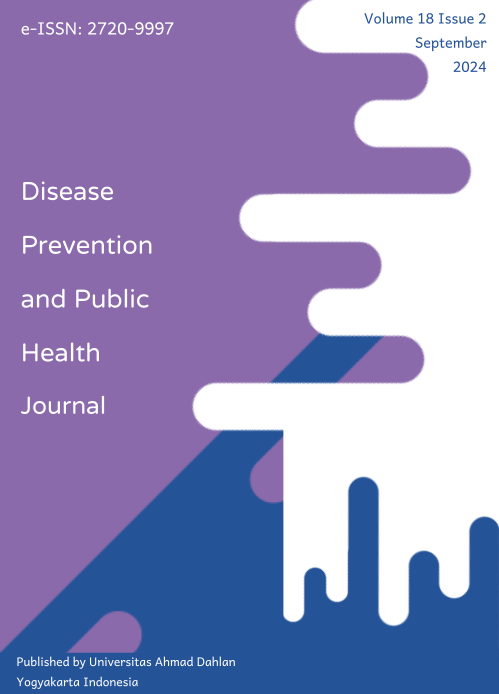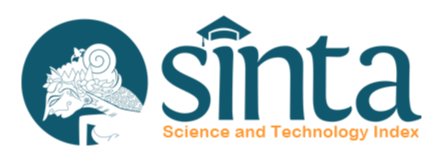A LITERATURE REVIEW: THE EFFECT OF AUDIO-VISUAL AND LEAFLET COUNSELLING ON SMOKING CESSATION KNOWLEDGE AND ATTITUDE IN YOUTH COMMUNITIES
DOI:
https://doi.org/10.12928/dpphj.v18i2.9663Keywords:
Audiovisual and Leaflet Counselling, Smoking Cessation Knowledge and Attitudes, Health Promotion, Literature ReviewAbstract
Background: Indonesia faces a serious threat due to the increasing number of smokers. Based on data BPS for 2020-2022, the percentage of people who smoke in Yogyakarta City is 23.97%, an increase from 24.54% in 2021. However, the proportion of children and adolescents aged 12 to 21 years who smoke is increasing in Sleman Regency. Furthermore, this increase represents a 16.1% increase in the approximately 200,000 youth living in Sleman District. Methods: The purpose of this study was to determine the effect of audiovisual counseling and leaflets on adolescents' knowledge and attitudes toward smoking cessation decisions in Candibinangun Pakem Village. Using Systematic Literature Review (SLR) research design. National and international literature indexes "Pubmed", "Google Scholar", "JAMA Network" and public health databases were used as samples. In data collection, extraction and analysis will be carried out using the PRISMA method. Results: The researchers identified 917 articles, including 199 from PubMed, 705 from Google Scholar, and 13 from JAMA Network, which were screened using the PRISMA method. The screening resulted in 8 articles, excluding 2 from the total of 6 articles, based on the identified keywords. Conclusion: The systematic review reveals that audiovisual media and leaflets significantly influence knowledge and attitudes, impacting implementation, acceptance, and outcomes. However, some behaviors are challenging to change due to environmental factors or lack of need. Therefore, community encouragement is needed to enhance knowledge and attitudes, particularly in reducing smoking prevalence.
References
Hallowell SG, Froh EB, Spatz DL. Human Milk and Breastfeeding: An Intervention to Mitigate Toxic Stress. Nurse OutlHolipah H, Sulistomo HW, Maharani A. Tobacco smoking and risk of all-cause mortality in Indonesia. PLoS One [Internet]. 2020;15(12 December):1-12. Available from: http://dx.doi.org/10.1371/journal.pone.0242558 PMid:33259522 PMCid:PMC7707492.
Ichsan B. Application of The Trans-Theoretical Model-Based Intervention on Smoking Behavior: A Systematic Review. Int Summit Sci Technol Humanit 2020. 2020;13-8. e-ISSN: 2615-1588.
Kendrich I, Sinaga BYM. Knowledge, Attitude, and Behavior Toward Smoking Among Medical Students in Universitas Sumatera Utara. Indones J Public Heal. 2023;18(1):1-10. https://doi.org/10.20473/ijph.v18i1.2023.1-10.
Ismail I, Siddiq R, Bustami B. The Effectiveness of Health Education Using Audiovisual on the Santri Smokers' Motivation to Stop Smoking. Asian Pacific J Cancer Prev. 2021;22(8):2357-61. https://doi.org/10.31557/APJCP.2021.22.8.2357 PMid:34452546 PMCid:PMC8629453.
Alhidayat NS, Latif AI. the Effectiveness of the Combination of Demonstration and Role-Play Methods To Improve Knowledge About Choking Management. J Islam Nurs. 2022;7(2):50-6. https://doi.org/10.24252/join.v7i1.32577.
Lei F, Zheng Y. Smoking Cessation Interventions for Chinese American Smokers: A Systematic Review and Meta-Analysis. Asian Pacific J Cancer Prev. 2023;24(3):753-68. https://doi.org/10.31557/APJCP.2023.24.3.753 PMid:36974527 PMCid:PMC10334092.
Herbert R, Sherrington C, Moseley A, Maher C. PEDro. Man Ther. 2000;5(1):49. https://doi.org/10.1054/math.2000.0372 PMid:11052901.
Page MJ, McKenzie JE, Bossuyt PM, Boutron I, Hoffmann TC, Mulrow CD, et al. The PRISMA 2020 statement: An updated guideline for reporting systematic reviews. BMJ. 2021;372. https://doi.org/10.1136/bmj.n71 PMid:33782057 PMCid:PMC8005924.
Samara AA, Rachiotis G, Pettemeridou S, Papastamatiou K, Tourlakopoulos K, Chelioti E, et al. Prevalence of tobacco use, exposure to secondhand smoke and knowledge on smoking cessation among students of health professions in Central Greece: A cross-sectional study. BMJ Open. 2020;10(10):1-8. https://doi.org/10.1136/bmjopen-2019-036512 PMid:33087367 PMCid:PMC7580046.
Alduraywish SA, Alnofaie MF, Alrajhi BF, Balsharaf FA, Alblaihed SS, Alsowigh AA, et al. Knowledge, attitude, and beliefs toward group behavior therapy programs among male adults attending smoking cessation clinics, cross-sectional analysis. BMC Public Health. 2021;21(1):1-8. https://doi.org/10.1186/s12889-021-10924-4 PMid:33952245 PMCid:PMC8101190.
Nia P, Noviana Nasriyanto E, Mei Winarni L. Hubungan Antara Tingkat Pengetahuan Tentang Dampak Merokok Bagi Kesehatan Dengan Motivasi Berhenti Merokok Di Sekolah Menengah Pertama SMPN 1 Sindang Jaya. Nusant Hasana J. 2022;2(6):10-5.
Kodir K, Yoga A, Saputri P. Pengaruh Pendidikan Kesehatan Dengan Media Audio Visual Terhadap Motivasi Berhenti Merokok Pada Mahasiswa. J Pengabdi Kpd Masy Sisthana. 2022;3(2):6-10. https://doi.org/10.55606/pkmsisthana.v3i2.7.
Siregar S, Sandika TW. Pengaruh Media Audio Visual pada Sikap Remaja tentang Bahaya Merokok. Amik Imelda [Internet]. 2019;557-63. Available from: http://sintaks.kitamenulis.id/index.php/Sintaks.
Alfianto MF, Habibie YA, Ridwan M, Zulfikar T, Salawati L. The correlations of knowledge, attitude, and smoking behaviour with smoking cessation effort at coffee shops in Banda Aceh, Indonesia. Bali Med J. 2020;9(2):451-5. https://doi.org/10.15562/bmj.v9i2.1729.
Sweatt,S.K, Gower, B.A, Chieh, A.Y, Liu, Y, Li L. Trajectories of Cigarette Smoking from Teens to Young Adulthood: 2000-2013. Physiol Behav. 2016;176(1):139-48 doi:10.1177/0890117117696358.
Kim YJ. Impact of work environments and occupational hazards on smoking intensity in Korean workers. Work Heal Saf. 2016;64(3):103-13. https://doi.org/10.1177/2165079915616397 PMid:26681605.
Macy JT, Chassin L, Presson CC. Smoking behaviors and attitudes during adolescence prospectively predict support for tobacco control policies in adulthood. Nicotine Tob Res. 2012;14(7):871-9. https://doi.org/10.1093/ntr/ntr301 PMid:22193576 PMCid:PMC3390551.
Anggraheny HD, Lahdji A. Enabling and Reinforcing Factor of Smoking Behavior in Rejosari Village, Semarang. 2020;24(Uphec 2019). https://doi.org/10.2991/ahsr.k.200311.006.
Golechha M. Health promotion methods for smoking prevention and cessation: A comprehensive review of effectiveness and the way forward. Int J Prev Med. 2016;2016-Janua. https://doi.org/10.4103/2008-7802.173797 PMid:26941908 PMCid:PMC4755211.
Baig M, Bakarman MA, Gazzaz ZJ, Khabaz MN, Ahmed TJ, Qureshi IA, et al. Reasons and motivations for cigarette smoking and barriers against quitting among a sample of young people in Jeddah, Saudi Arabia. Asian Pacific J Cancer Prev. 2016;17(7):3483-7.
Almutairi M K. Attitudes of Students and Employees Towards the Implementation of a Totally Smoke Free University Campus Policy at King Saud University in Saudi Arabia: A Cross Sectional Baseline Study on Smoking Behavior Following the Implementation of Policy. J Community Health [Internet]. 2014;39. Available from: https://link.springer.com/article/10.1007/s10900-014-9893-z https://doi.org/10.1007/s10900-014-9893-z PMid:24906791.
Abdelwahab SI, El-Setohy M, Alsharqi A, Elsanosy R, Mohammed UY. Patterns of use, cessation behavior and socio-demographic factors associated with smoking in Saudi Arabia: A cross- sectional multi-step study. Asian Pacific J Cancer Prev. 2016;17(2):655-60. https://doi.org/10.7314/APJCP.2016.17.2.655 PMid:26925659.
Al-Mohrej OA, Altraif SI, Tamim HM, Fakhoury H. Will any future increase in cigarette price reduce smoking in Saudi Arabia? Ann Thorac Med. 2014;9(3):154-7. https://doi.org/10.4103/1817-1737.134070 PMid:24987474 PMCid:PMC4073572.
Alyamani DM, Alkriadees Y, Alkriadees K, Sharahili E, Mesained AB. Determinants and Predictors of Smoking Cessation Among Undergraduate and Graduate Medical Students: a Cross-Sectional Study in a Private Medical College. Int J Adv Res. 2016;4(12):1608-17. https://doi.org/10.21474/IJAR01/2562.
Tobaiqy M, Thomas D, Maclure A, Maclure K. Smokers' and non-smokers' attitudes towards smoking cessation in Saudi Arabia: A systematic review. Int J Environ Res Public Health. 2020;17(21):1-12. https://doi.org/10.3390/ijerph17218194 PMid:33171946 PMCid:PMC7664210.
Mahdi HA, Elmorsy SA, Melebari LA, Al-Masudi SM, Sharbini DA, Najjar AG, et al. Prevalence and intensity of smoking among healthcare workers and their attitude and behavior towards smoking cessation in the western region of Saudi Arabia: A Cross-sectional study. Tob Prev Cessat. 2018;4(August):1-8. https://doi.org/10.18332/tpc/93787 PMid:32411856 PMCid:PMC7205148.
Jradi H. on the Circadian Pattern of Melatonin Report. Ann Thorac Meedicine. 2017;13(3):156-62. DOI: 10.4103/atm.ATM_45_17.
Chowdhury S, Chakraborty P pratim. Universal health coverage There is more to it than meets the eye. J Fam Med Prim Care [Internet]. 2017;6(2):169-70. Available from: http://www.jfmpc.com/article.asp?issn=2249-4863;year=2017;volume=6;issue=1;spage=169;epage=170;aulast=Faizi https://doi.org/10.4103/jfmpc.jfmpc_13_17 PMid:29026777 PMCid:PMC5629889.
Notoatmodjo S. Pendidikan dan Perilaku Keehatan. In: Pendidikan Kesehatan [Internet]. Jakarta; 2003. p. 210. Available from: https://opac.perpusnas.go.id/DetailOpac.aspx?id=50667.
Reskiaddin LO, Supriyati S. Proses Perubahan Perilaku Berhenti Merokok: Studi Kualitatif Mengenai Motif, Dukungan Sosial dan Mekanisme Coping. Perilaku dan Promosi Kesehat Indones J Heal Promot Behav. 2021;3(1):58. https://doi.org/10.47034/ppk.v3i1.4142.
Akmal D, Widjanarko B, Nugraha P. Sikap Mempengaruhi Niat Berhenti Merokok pada Remaja SMA di Kota Bima. Promosi Kesehat Indones. 2017;12(1):91. https://doi.org/10.14710/jpki.12.1.78-91.
Aderita NI, Ningsih S, Yuliyanti T. Hubungan antara Sikap, Norma Subjektif, dan Persepsi terhadap Intensi Berhenti Merokok pada Remaja Putra Sekolah Menengah Atas. J Ilm Permas J Ilm STIKES Kendal. 2023;13(3):751-60 https://doi.org/10.32583/pskm.v13i3.585.
Downloads
Published
Issue
Section
License
Copyright (c) 2024 Universitas Ahmad Dahlan

This work is licensed under a Creative Commons Attribution-ShareAlike 4.0 International License.
Authors transfer the copyright and grant the Disease Prevention and Public Health Journal right of first publication with the work simultaneously licensed under a Creative Commons Attribution License (CC BY-SA 4.0) that allows others to share (copy and redistribute the material in any medium or format) and adapt (remix, transform, and build upon the material) the work for any purpose, even commercially with an acknowledgement of the work's authorship and initial publication in Disease Prevention and Public Health Journal. Authors are able to enter into separate, additional contractual arrangements for the non-exclusive distribution of the journal's published version of the work (e.g., post it to an institutional repository or publish it in a book), with an acknowledgement of its initial publication in Disease Prevention and Public Health Journal. Authors are permitted and encouraged to post their work online (e.g., in institutional repositories or on their website) prior to and during the submission process, as it can lead to productive exchanges, as well as earlier and greater citation of published work (See The Effect of Open Access).

This work is licensed under a Creative Commons Attribution-ShareAlike 4.0 International License.







